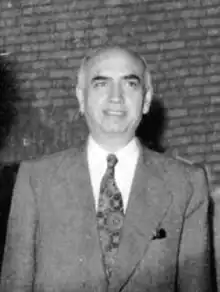Mohammad Ali Varasteh
Mohammad Ali Varasteh (1896–1989) was an Iranian statesman who held several cabinet posts in the 1950s and also, served as the governor of Isfahan Province. He was the head of the regency council which was formed soon after the Shah Mohammad Reza Pahlavi left Iran in January 1979.
Mohammad Ali Varasteh | |
|---|---|
 | |
| Minister of Finance | |
| In office March 1951 – 4 October 1951 | |
| Monarch | Mohammad Reza Pahlavi |
| Prime Minister | |
| Succeeded by | Mahmoud Nariman |
| Minister of Health | |
| In office 4 April 1950 – June 1950 | |
| Monarch | Mohammad Reza Pahlavi |
| Prime Minister | Ali Mansur |
| Preceded by | Amir Alam |
| Succeeded by | Jahanshah Saleh |
| Personal details | |
| Born | 1896 |
| Died | 1989 (aged 92–93) Tehran, Iran |
Biography
Varasteh was born in 1896.[1] He served as the minister of health in the cabinet led by Prime Minister Ali Mansur between 4 April and June 1950.[2] Varasteh replaced Amir Alam in the post, and his successor as health minister was Jahanshah Saleh.[1] In March 1951 Varasteh was named as the minister of finance in the cabinet led by Hossein Ala'.[3] However, his tenure ended on 27 April when the cabinet resigned.[3] On 2 May Varasteh was appointed to the same post in the next cabinet led by Prime Minister Mohammad Mosaddegh.[3][4] He became one of the members of the Committee of Expropriation which was founded by Mosaddegh in May 1951 to eliminate the control of Britain in Iran's oil industry.[5] Varasted was also head of the Iranian delegation which had been formed to implement this process.[6][7] He resigned from office and was replaced by Mahmoud Nariman as finance minister.[6]
Following the coup in 1953 which ended the premiership of Mosaddegh Varasted was appointed the governor of Isfahan province.[8] Then he was made a senator.[9] In 1963 the protests led by religious figures intensified in Iran due to the policies of the Shah, Mohammad Reza Pahlavi.[9] Hossein Ala', Abdollah Entezam and Varasteh personally expressed their concerns about Shah's policies and their potential results which made all of them outsiders in the court of the Shah.[9] In addition, Ala' and Entezam were dismissed from the Senate of Iran to which they had just been appointed.[9]
Soon after the Shah left Iran a regency council was established to undertake the duties of the Shah in January 1979.[10] Varasteh was named as one of the members of the council.[11] Initially Seyed Jalaleddin Tehrani was named as the head of the council, but he resigned soon.[12] Varasted replaced him as the chair of the regency council.[8][12] He died in Tehran in 1989.[8]
References
- Mohammad Hossein Azizi (2007). "The Historical Backgrounds of the Ministry of Health Foundation in Iran". Archives of Iranian Medicine. 10 (1): 123. PMID 17198470.
- "Developments of the Quarter: Comment and Chronology". The Middle East Journal. 4 (3): 337. July 1950. JSTOR 4322192.
- "Developments of the Quarter: Comment and Chronology". The Middle East Journal. 3 (3): 342–343. Summer 1951. JSTOR 4322297.
- Katayoun Shafiee (2018). "Technopolitics of a concessionary contract: How international law was transformed by its encounter with Anglo-Iranian oil" (PDF). International Journal of Middle East Studies. 50 (4): 631. doi:10.1017/S0020743818000909. S2CID 158553099.
- Fariborz Mokhtari (2016). "Review of Iran's 1953 Coup: Revisiting Mosaddeq". Bustan: The Middle East Book Review. 7 (2): 119. doi:10.5325/bustan.7.2.0113. S2CID 185086482.
- Alan W. Ford (1954). The Anglo-Iranian Oil Dispute of 1951-1952. Berkeley and Los Angeles, CA: University of California Press. p. 122.
- "No. 65 Editorial Note". Office of the Historian. Retrieved 31 January 2022.
- Manshour Varasteh (2013). Understanding Iran's National Security Doctrine. Leicestershire: Matador. p. 176. ISBN 978-1-78088-557-5.
- Fakhreddin Azimi (2009). Quest for Democracy in Iran: A century of struggle against authoritarian rule. Cambridge, MA; London: Harvard University Press. p. 177. ISBN 978-0-674-02036-8.
- R.W. Apple Jr. (14 January 1979). "A Regency Council is Named to Assume Duties of the Shah". The New York Times. Tehran. Retrieved 31 January 2022.
- Sepehr Zabir (2012). The Iranian Military in Revolution and War (RLE Iran D). London; New York: Routledge. p. 52. ISBN 978-1-136-81270-5.
- Mehrdad Khonsari (June 1995). The National Movement of the Iranian Resistance 1979-1991: The role of a banned opposition movement in International Politics (PhD thesis). London School of Economics. p. 111.
External links
 Media related to Mohammad Ali Varasteh at Wikimedia Commons
Media related to Mohammad Ali Varasteh at Wikimedia Commons